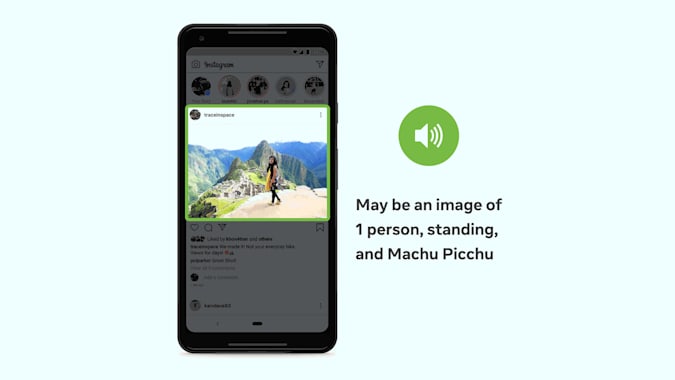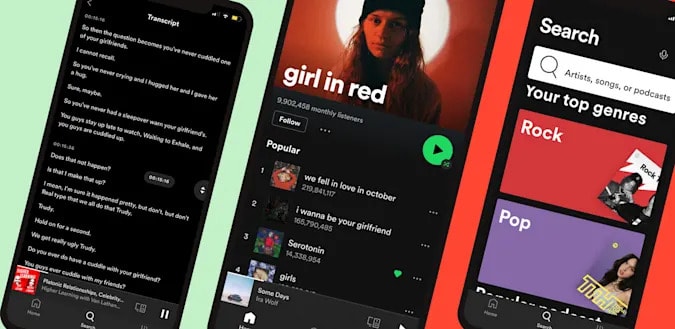Photo credit: Carlos Barria / Reuters
Meta / Facebook
Amid all the drama about Facebook, its whistleblower, and its rebranding this year, it’s easy to overlook the company’s updates on accessibility. In early 2021, the company updated its Automatic Alt Text (AAT) system to recognize over 1,200 objects and concepts in photos on Instagram and Facebook. According to Meta, that was a 10-fold increase since AAT’s debut in 2016. It also introduced additional features for Facebook on iOS that provided more detailed descriptions like the position of objects in an image and their relative sizes.
Unfortunately, when these updates were released, Facebook may have damaged some accessibility features. Rachfal said shutting down its facial recognition system this year resulted in less informative descriptions for blind or visually impaired users. Rachfal said this change was “made for privacy reasons” and he believes these decisions were made without considering accessibility and the disabled community. “They also haven’t received the same weight and consideration as privacy concerns,” added Rachfal.
Facebook has published a post on this topic in November. In it, the company’s Vice President for Artificial Intelligence, Jerome Pesenti, wrote: “We have to weigh the positive use cases for facial recognition against the growing social concerns, especially since the supervisory authorities do not yet have to lay down clear rules.”
Meta
In the post, Pesenti recognizes the critical role facial recognition plays at AAT in helping blind and visually impaired users identify their friends in pictures. But while some facial recognition tools like identity verification remain in place, for the most part, features like notifying users of photos they may contain or auto-tagging their friends will be phased out. This applies to both sighted and visually impaired users.
“We know that the approach we have chosen involves some difficult compromises,” Pesenti wrote, adding, “we will continue to be involved in this conversation and work with the civil society groups and regulators who are leading this discussion.”
Elsewhere in the Meta family of products, the company added an accessibility tab to the Oculus settings menu to make it easier to find help functions. It also brought in color grading and raise view tools to offer more readable palettes and provide a standing perspective for seated users. Meta said it’s still iterating on Raise View, working with the Oculus community to improve the feature, and permanently adding it to the accessibility menu when it’s done.
Meta has also partnered with ZP Better Together, a company that makes technology for deaf and hard of hearing users to Include sign language interpreters in video calls on Portal devices. From December, deaf or hard of hearing people can also apply on the ZP website for free portals that are supplied with the ZP apps.
Handout. / Reuters
Facebook Introduced clubhouse-style audio rooms in the US this year and especially with live subtitles included from the start. It also includes a visual cue to show who is speaking and provides subtitles for other audio products like Soundbites and podcasts on iOS and Android.
Let’s not forget the company’s renaming to Meta this year and its new focus on the Metaverse. “We’re already working to bring the Metaverse to life and look forward to exploring the breakthrough opportunities it offers to make the digital world more accessible and inclusive for people with disabilities,” said Mike Shebanek, head of Accessibility.
We’ll have to wait and see if and how that comes true, but in the meantime, Meta needs to keep engaging with the accessibility community to ensure that the extension of the Metaverse is inclusive from the start.
Twitter only set up its two accessibility teams last year after an embarrassing introduction of voice tweets that excluded deaf and hard of hearing users due to a lack of subtitles. However, since then the company has shown a remarkable improvement. In 2021, Twitter introduced closed captions for voice tweets, added closed captions and accessibility labels in spaces, and brought automatic video captions. According to the company, the latter is “available worldwide in most languages” and is supported on Android, iOS and on the web.
A few months ago we introduced video caption uploading. Starting today, all videos will be automatically subtitled.
To view them, enable the subtitles in your mobile device’s settings or select the CC button on the web.
What do you think of the experience? https://t.co/fywdjC6yDI
– Twitter accessibility (@ TwitterA11y) December 14, 2021
While this may seem like a small series of updates compared to the other companies in this roundup, Twitter also has a smaller product portfolio. Nevertheless, we managed to make significant changes. Rachfal hailed Twitter as “the first social media platform to boldly ask users to add alt text to images,” although he noted that filling in the field is still optional.
Other notable technical developments this year
Alt text and subtitles continue to be difficult accessibility features for the industry. These are labor-intensive processes that companies tend to delegate to AI, which can lead to garbled, inaccurate results. This was particularly evident at this year’s virtual E3 gaming convention at the illegible subtitles sometimes made the show incomprehensible to those who relied on subtitles to understand the announcements.
There are also large parts of the online world in dire need of accessible upgrades. According to a February 2021 study by WebAIM (Web Accessibility in the sense), for example, a whopping 97.4 percent of websites had errors that meet the guidelines for web content accessibility (WCAG 2). The most common mistakes included missing alt text, low-contrast text, missing labels for form input, and more.
It’s not just websites that need work: other media formats also need to be made more integrative. The National Association of the Deaf (NAD), for example filed a lawsuit with Disability Rights Advocates (DRA) this year against three major podcast providers: SiriusXM, Stitcher and Pandora.
Spotify
Because the three defendants “do not provide transcripts or captions for the podcasts offered on their platforms, more than 48 million deaf and hard of hearing Americans are denied full and equal enjoyment of the content they offer their hearing,” according to the NAD. User. ”Meanwhile Spotify announced this year that it will start offering auto-generated transcripts for podcasts, and Amazon Music synchronized transcripts started in November.
Then there are entire industries that could use improvements in accessibility. Rachfal points out that health care for the blind or visually impaired is a continually problematic area. “This is still an entire sector that we hear about far too often from our members,” he said. Given that we are currently in the quagmire of the third wave of COVID-19, it is inexcusable to continue excluding people with disabilities when it comes to scheduling vaccinations or testing appointments.
In November this year, the Ministry of Justice announced It had reached an agreement with Rite Aid to open websites for COVID-19 testing and vaccinations. Rite Aid’s vaccine registration portal was incompatible with some screen readers and was inaccessible to “people who have difficulty using a mouse.” For example, the calendar on its website “did not show screen reader users any available appointment times,” while those who rely on keyboard-based navigation instead of a mouse cannot use the tab key to fill out a consent form that is required to schedule appointments .
The ACB also worked with CVS to provide accessible prescribing information in all locations across the country. This includes a Spoken RX function would read the prescription labels via the CVS pharmacy app.
While there have been many transgressions in the past year, we have also seen many promising developments to ensure that the technology is inclusive. The FCC, for example proposed rules in December to make emergency alerts more useful and informative for the deaf or hard of hearing.
KAREN BLEIER via Getty Images
Meanwhile, as of March 2021, HBO Max has launched 1,500 hours of audio-written content and is committed to adding the descriptions to all newly produced original content and adding more to its back catalog. Also, in collaboration with the Coalition for Inclusive Fitness, Planet Fitness said It will buy and install accessible exercise equipment in its stores across the country.
I’ve only scratched the surface of this round-up of updates. Most encouraging, however, is the increasing willingness of companies to partner with disability rights groups and advocates in the earliest stages of product development. Lizzie Sorkin, Director of Engagement at NAD, said “More and more companies are reaching out to us for input at the beginning, not late in the process.” Rachfal also noted a “growing commitment to accessible media and content” that “emerged from ACB lobbying and the audio description project through joint discussions with industry”.
All products recommended by Engadget are selected by our editorial team independently of our parent company. Some of our stories contain affiliate links. If you buy something through one of these links, we may earn an affiliate commission.



